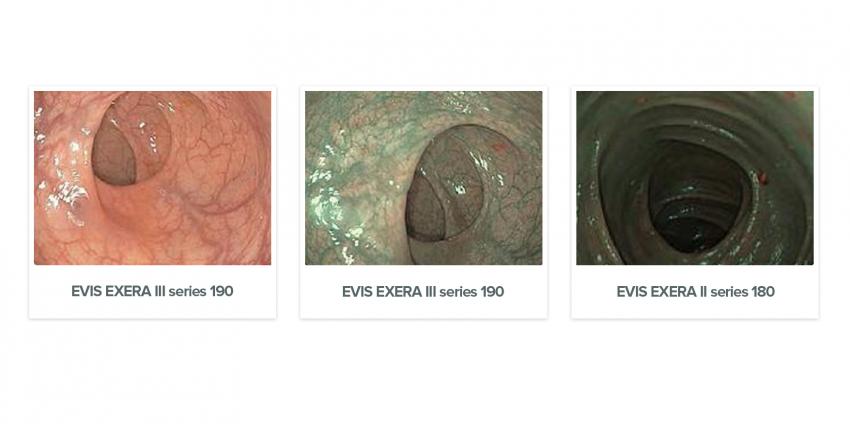OLYMPUS NARROW BAND IMAGING (NBI) IN GASTROENTEROLOGY
Several years ago, Olympus started to actively introduce Narrow Band Imaging (NBI) technology into the healthcare services market, and as of today, the technology has already established new quality standards in endoscopy. NBI technology employed in the EVIS EXERA III endoscopy systems brings the diagnostic value to a whole new level.

Narrow band imaging is a powerful optical image enhancement technique which significantly increases the visibility of blood vessels, muscle and other tissue structures in the mucous membrane. This is achieved due to special narrow-band light utilization excluding all wavelengths except 415 nm (blue) and 540 nm (green). This technology has become common use in various areas of the healthcare industry such as urology and otolaryngology in particular, and it is also used in bronchoscopy. However, narrow band imaging has found true acceptance in gastroenterology. Why is that so? Let us look for the answer together.
The capability of hemoglobin to selectively absorb certain visible light spectrum wavelengths is the basis of this technology. Consequently, when a gastrointestinal tract surface is illuminated by a narrow-band beam, the light is actively absorbed by the vessels but is reflected by the mucous membrane. Short wavelengths are absorbed by surface vessels, whereas long wavelengths are absorbed by vessels located deeper in the tissue. This feature makes it possible to contrastively isolate capillaries and other mucous membrane structures. The visualization of surface vessels is of great importance for the diagnosis of tumors characterized by high vascularization, while imaging of deep vessels facilitates identifying various focal lesions.
To fully implement its narrow band imaging technology, Olympus has developed a completely new video endoscopy system, called EVIS EXERA III, improving every component of its predecessor to obtain high-quality images. The innovations, applied in the new system, allow a two-fold increase in viewable distance and considerably enhanced imaging quality as compared to the EVIS EXERA II system, and therefore, significantly improve the speed and efficiency of endoscopic procedures.
Narrow band imaging technology diagnostic advantages
Using NBI technology, esophagogastroduodenoscopy significantly improves screening and subsequent Barrett’s esophagus observation efficiency. Compared to white light endoscopy, it also ensures a much higher squamous cell carcinoma detection rate, as well as facilitates other forms of head, neck and upper gastrointestinal tract superficial cancer diagnosis.

With the EVIS EXERA III 190 series system and NBI, colonoscopy procedures become more cost-efficient providing better visual differentiation of hyperplastic and adenomatous colorectal polyps, thus reducing histopathology costs.
The Olympus Company offers a number of endoscopes, intended for use in gastroenterology, compatible with the EVIS EXERA III system. Let us review the available product line.
Gastroscopes: the super-thin GIF-XP190N and GIF-H190 scopes are equipped with a built-in channel for water supply. Both devices have excellent ergonomics, a wide field of view expanded to 140 degrees and a special immersible connector which does not require any additional waterproof casing.
Video endoscopes: the GIF-1TH190 scope is a slim design gastrointestinal video endoscope with a reduced distal end diameter and a wide 3.7 mm instrument channel. It also provides the possibility of supplying a direct water flow and has the aforementioned immersible connector which ensures multifold possibilities to perform a variety of image-guided therapy procedures.
The GIF-2TH180 video gastroscope, which is equipped with two instrument channels of 3.7 mm and 2.8 mm in diameter respectively and a rather small, only 12.2 mm in diameter, distal end, ensures great maneuverability and allows complex qualitative examinations and image-guided therapy in the upper gastrointestinal tract.
Video colonoscopes: the CF-H185 scope is available in two variations – CF-H185L (1680 mm working length) and CF-H185I (1330 mm working length). The scopes’ key features include the close focus function which provides a 2 mm minimum depth of field and the possibility to adjust the endoscope rigidity which makes working with it extremely convenient for the doctor and comfortable for the patient.
All video endoscopes of the series support HDTV image quality – a very important feature which allows further improvement of the imaging quality necessary for diagnostic and treatment procedures, and in combination with the narrow band imaging technique, it allows achieving incredible results.
Finally, it should be noted that such advanced manufacturers as Olympus, being present on the medical equipment market, make all the difference by stimulating innovations introduction into the medical equipment production industry which diligently moves modern healthcare services into a bright future.
21.05.2017